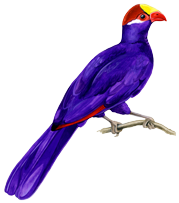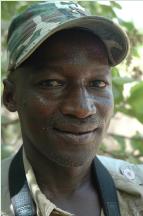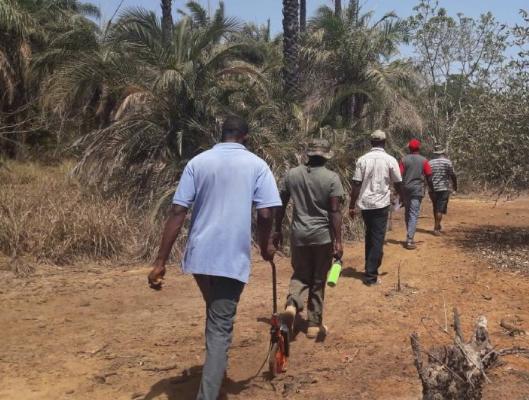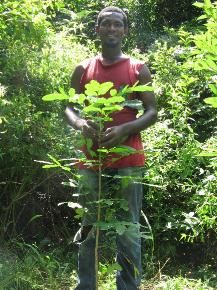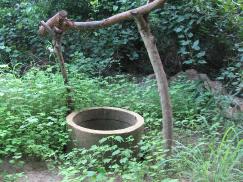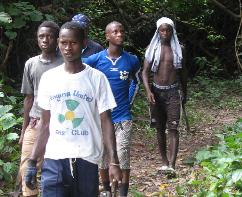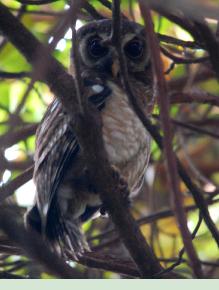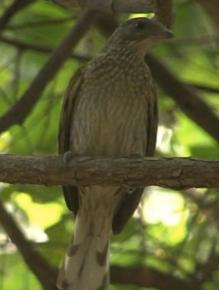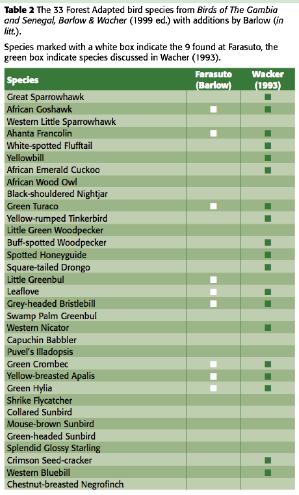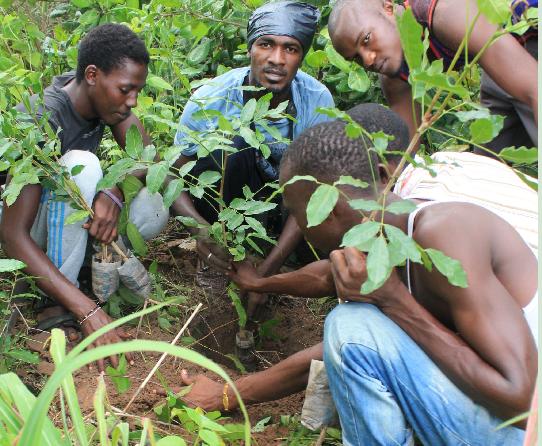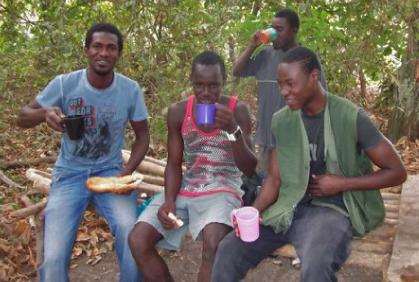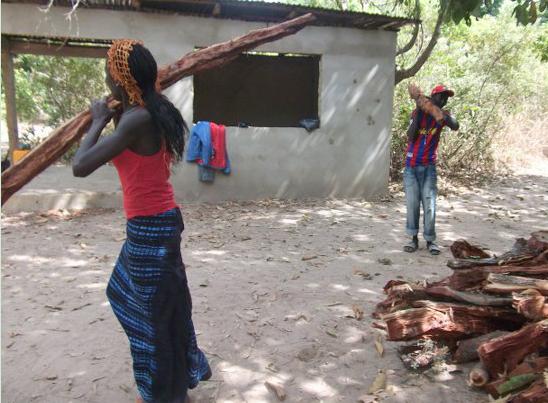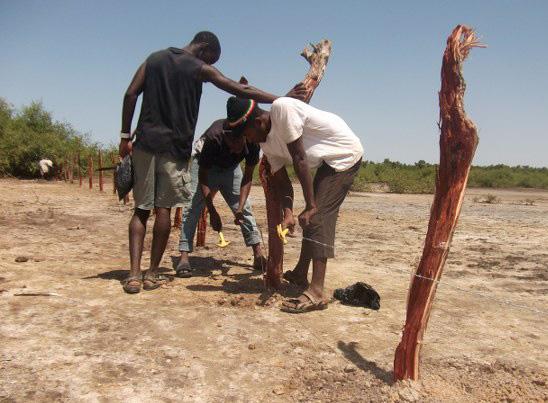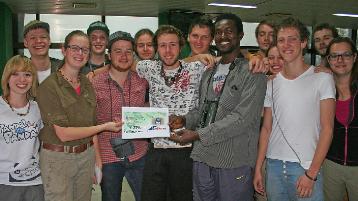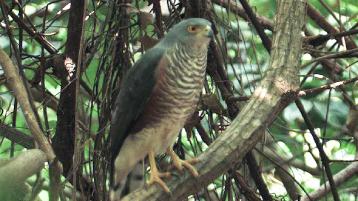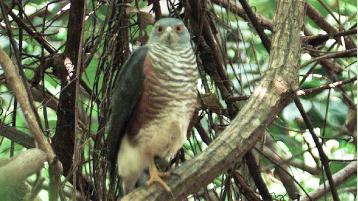 |
||

|
The Violet Turaco, Musophaga violacea; with open wings the scarlet of the flight-feathers is striking. Not wholly dependent on climax forest but certainly typical of it – the reason the bird was chosen locally for the logo of Farasuto Forest Community Nature Reserve |
Latest developments
Below are listed Latest Developments back from 9 March 2009, please see Previous development reports
Update 21 September 2022
My brother Peter and I were introduced to Farausto by Babagellegh (Baba) Bah in January 2009 while on a family birding trip to The Gambia and we launched this website later that year, Peter being the webmaster.
Farasuto (‘far forest’) turned out to be a previously ‘unknown’ 2.8ha patch of primary coastal or Guinea-Congo forest, one of a handful of remaining examples with then a total area of 104ha in The Gambia. With grant aid I wrote a Management Plan website for the site and delivered it to The Gambia in 2010.
Since then advances have been made in several aspects of the site’s security and development and several generous donors have been and are still associated with the site and its progress – see Latest Developments website. The indications are that most if not all the site’s forest obligate bird species continue to occur there, with for example Wood Owl added since the Plan was published.
The involvement of Peter and I is being drawn to a close in September 2022.
We wish FFNCR and its wildlife, the people of Kuloro and Tungina and all those associated with the site, well for the future. The website will continue to be accessible, but will not receive any updates.
John and Peter Tucker
Latest Developments 20 – September 2019
It is worth reflecting that this Farasuto forest website was launched by my brother Peter and I more than a decade ago, in March 2009. With grant aid I wrote the Management Plan in 2009/10 and took it to The Gambia in April 2010. The Plan received thanks and praise from a range of government officials who I met to present copies, from the Hon. Mr Jato Sillha, then Minister of State for Forestry and the Environment and Mr Alpha Jallow, then Director of the Department of Parks and Wildlife Management, onwards. Of course there was no suggestion of local funding – none had been anticipated. However the crash in world financial systems at the time scuppered my plans to apply for funding from major institutions.
Since then there have been a succession of increasingly helpful, kind and generous benefactors supporting the work of the KBO in their efforts to ensure the long-term survival of Farasuto Forest Community Nature Reserve, probably the most secure patch of native wet evergreen forest left in The Gambia.
THIS YEAR
In 2019 we have seen the full impact of especially recent major funding from Peter Bloom and his team, of funds donated by visitors to APAB at the at Flamingoland visitor attraction in North Yorkshire and to Knowsley Safari near Prescot, Liverpool. Thanks also to another generous anonymous donor from Denmark.
The fencing of the site has always been a major priority, to exclude grazing cattle and secure the future of the trees and their successors. Equally important, if not more so, will be the secondary effect that the fencing and associated works has had on local attitudes to the site. The dedication of the wardens and the site infrastructure they have been able to put in place, will have affected local attitudes to the site and helped to secure its future, especially from the inevitable pressure of tree-cutting. Allied to the fencing with the associated gate has been the visitor hut and its ‘his’ and ‘hers’ loos, complete with tiled floors.
The pictures and video clips below show the impressive progress made on site largely in the last year. Meanwhile Peter and I, in close contact with the KBO, continue to maintain this website. The team in England has been joined recently by Lyn Tyrer of Knowsley Safari. Lyn is involved with other projects in The Gambia, visits the country quite frequently and is a valuable personal link to Mustapha Kassama and his KBO team in Kuloro and at Farasuto.
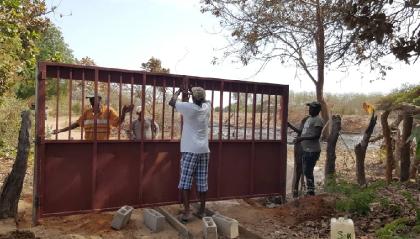
An impressive pair of gates going up at the entrance to the site.
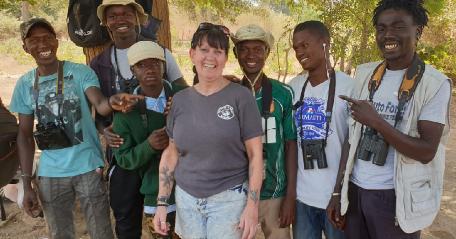
Some of the Bird Guides at Farasuto; July 2019.
Buba Bah, Sanna Batchilly, Lamin Darboe, Lyn Tyler, Mustapha Cesar, Modou Barry and Buba Kambi.
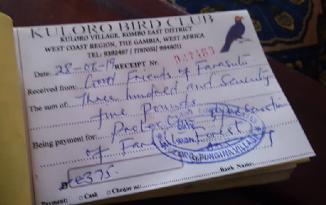
An official KBC receipt at the gate, here for a sizable donation.
The most recent list of committee members of the Kuloro Bird Club:
President: Babagalleh Bah (Baba)
Vice President:. Dembo Sonko
Secretary: Amadou Barry
Public Relations Officer: Yaya Barry
Finance Officer: Mustapha Kassama
Finance Office: Mustapha Manneh
Editor: Ebrima W. Barry
Latest Developments 19 – February 2019
The year 2018, almost a decade since the Management Plan was published, has produced great progress at the forest.
April saw the significant Memorandum of Understanding signed by senior representatives of the two settlements of Kuloro and Tungina and the District. It recognises Farasuto Forest as “not for lease, sales or rent but rather a nature reserve for both communities” – see below. It is signed by both Alkalos, (Head Men) of Kuloro and Tunjina, by representatives of both Village Development Committees, the President of the Kuloro Bird Club (KBC) and the District Chief. It represents another step towards the long-term security of the site.


Early in the year Peter Bloom of All Parots and Birds Ltd who runs the Bird Display at Flamingo Land, North Yorkshire, contacted the team and offered to support the project to fence the site. The aim was to exclude cattle which from time to time would enter the edges of the site and graze down the vegetation, including young trees. Thanks to voluntary donations by visitors to the Bird Display, and also from The Jungle Zoo in Cleethorpes, nearly £3,000.00 has been sent to the team in The Gambia.
This has enabled the completion of a 6-strand barbed wire (in part chain-link) fence around the three sides of the reserve away from the river so adding another level of safeguard for the forest and Peter Bloom, his team and the donors to the project are most gratefully thanked.
This has added another level of safeguard for the forest and Peter Bloom, his team and the donors to the project are most gratefully thanked.
APB’s appeal on behalf of FFCNR at the Flamingo Park:
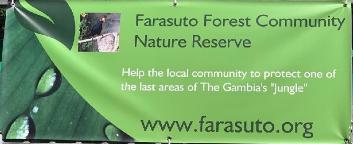


Farasuto’s new barbed wire fence, is keeping cattle out
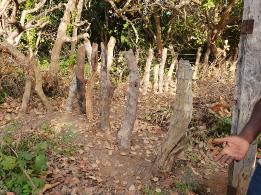
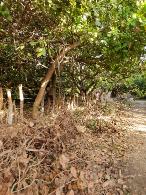
Members of the KBC beside FFCNR’s fence
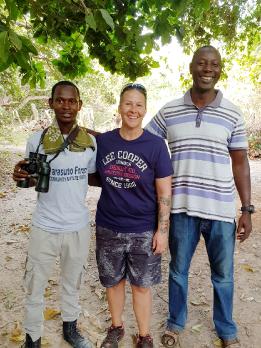
Ellie Shurlock, from the staff at APB’s Bird and Sealion Park, at Farasuto in December 2018 with Mamadou Kassamsa and another member of the KBC. Photo: Lyn Tyrer.
In the first days of the new year contact has been established by another, personal donor, offering a generous standing order donation to the site, which will facilitate further improvements at Farasuto. A further donor has kindly offered a donation specifically for the completion of the visitor hut and loo.
Above all the local dedicated efforts of the KBC committee and the work-teams on the ground are to be congratulated. Over the years the officers of the Club have engaged the interest and support of visitors to The Gambia and to Farasuto in particular – gaining their affection and support for the place. Lately that work has been undertaken especially by Babagelleh Bah and Mustapha Kassama whose warm-hearted and efficient manner is greatly admired.
Latest Developments 18 – May 2018
Mustapha Kassama recently met Peter Bloom who was on holiday from Yorkshire, England. Mustapha, well know to John Tucker from 2009 and 2010, is now Financial Controller for the KBS, while Babageleh Bah is currently the President. It was Baba who first introduced John to Farasuto in 2009.
|
Babagaleh Bah – |
Since the Management Plan of 2010 probably the top priority, fencing the site against the grazing of cattle, has remained an issue with some work being done on it. Another priority, immediately following the fencing, has been tree planting; it was soon begun and is continuing as reported in previous uodates, to ensure the continuation of a closed forest canopy.
Peter Bloom is a Director of APAB Ltd who are involved in the presentation of Birds for Displays, Film and media work in the UK that feature several birds that are indigenous to The Gambia. He was impressed by the commitment and enthusiasm of Mustapha and the KBC to the forest and is offering to donate some of the annual charitable funding raised by his staff at the Flamingo Land Bird Show, Malton, North Yorkshire, to the fencing issue.
|
Some of the KBC walking the forest boundary, |
The first payment in May of £250 will help fund the systematic survey work currently (late April into May) going on to check the entire 1km boundary of the forest to determine exactly where gaps remain in the fencing, calculate the cost of the task of closing them and paying for materials and labour.
Latest Developments 17.
December 2015
John & Peter Tucker and Mamadou W Jallow, Shropshire, Oxfordshire and The Gambia.
|
Forest regeneration 2015 |
As the time since John and Peter’s initial involvement at Farasuto lengthens, JT was last there in April 2010, so these reports become less frequent. But J&P I remain in contact with the forest via the KBO (Kuloro Bird Organisation), especially Mamadou W. Jallow, who from time to time sends us news and photographs. The Management Plan which JT produced with PT, and JT took out to The Gambia in 2010, with this website kindly created and maintained by PT, together with all the works by Mamadou and the KBO, have raised the profile of the site and helped in the work done to save, maintain and improve the site and its facilities.
- Since JT’s last visit and with funding help from friends the reserve has seen:
- Fencing against the cattle which used to enter the reserve and graze down some of the undergrowth, scrub and young trees.
- The fence paved the way to the planting of young trees to replace those damaged and removed by grazing.
- In 2014 further funding enabled the start to the hut at the entrance to the forest – though not yet complete it provides a base and shelter for both the KBO during work-parties and shade for visitors.
- A cement-lined well was constructed in 2015; water is now provided at a few bird-baths around the reserve, focal points for visitors taken to the site by the bird guides.
- Further funding for the hut could enable the addition of other facilities there, including perhaps a sustainable composting toilet – which could be a first for any nature reserve in the country!
|
New well 2015 |
For the progress made with all these, all of which have cost money, we have several sponsors to thank, besides of course the local volunteers from Kuloro who do the practical work. Funds raised by visiting students from Eco & Wildlife Studies department of Helicon MBO Geldermalsen in The Netherlands enabled the fencing and a start to tree-planting and the construction of the entry-gate hut in 2013, see earlier updates. More recently John Kitchin kindly secured the funds (£300) to enable the creation of the cement-lined well, the money relayed via Dr Roy Armstrong of Cumbria University, another long-term supporter. Thanks go from the KBO, Farasuto Forest itself and John & Peter for all this help.
The photographs with this update, from Mamadou in early October 2015, are of the KBO work parties clearing paths for the coming dry season’s visitors, the recently-completed well and the hut.
|
Brush clearance work party, 2015 |
It is six years since Clive Barlow carried out his careful and detailed examination of the birds at Farasuto, for the Management Plan. Clive did an early morning visit on 21 December 2009 and listed many species, some of them being ‘forest obligates’ for which the site is so special, despite its small size (about equivalent to three football pitches). Clive will carry out a repeat of that survey to see how many species survive - is the site successful at maintaining the bird species for which it is so special? Two other surveys will be carried out by Clive over the coming year, at optimal dates in both the wet and dry seasons – both as baselines for future monitoring at probably 5-year intervals.
Latest Developments 16.
December 2013
Correspondence with Farasuto Forest Community Nature Reserve.
Please note that until further notice The Gambia address for correspondence about the Forest is mamadou.w.jallow@farasuto.org
Mamadou W Jallow is the key contact there and he is also available at his personal address: mamadouwj@yahoo.co.uk
Our thanks to Mamadou for taking on the key role in the improvements to the site.
New bird species for Farasuto Forest.
A Wood Owl was recorded in Farasuto on 11 July this year. It was seen by Mamadou and photographed by Annemijn Groot; Clive Barlow has accepted the record and hopes to write it up, with MWJ, in the journal Malimbus.
|
African Wood Owl (Strix woodfordii) in Farasuto Forest on 11 July 2013. Photo Annemijn de Groot. |
This owl is a ‘forest specialist’ species and is known from nearby Pirang forest (Clive Barlow) but this is the first record of bird from Farasuto. It brought the number of ‘forest specialist’ bird species recorded in Farasuto to ten; see Table 2 on page 28 of the Management Plan and below.
In preparing the material for this report we chanced upon a record of yet another forest specialist bird in Farasuto. On 2 January 2012 Daniel Jimenez recorded a very nice video of a Spotted Honeyguide (Indicator maculatus) in Farasuto from which we reproduce a still below. The full video is at The Internet Bird Collection at website
|
Still from a video of a Spotted Honeyguide (Indicator maculatus) made at Farasuto on 2 January 2012. |
Spotted Honeyguide (Indicator maculatus) from a video recording made at Farasuto on 2 January 2012. With acknowledgements to The Internet Bird Collection and the photographer Daniel Jimenez.
The honeyguide brings the number of ‘forest specialist’ bird species recorded at Farauto at eleven, equal to that known from Abuko Forest – see Table 2 from FFCNR’s Management Plan below and it emphasises the significance of Farasuto among the remaining fragments of ‘Guinea Congo’ forest in The Gambia.
|
Table 2 from the FFCNR |
The honeyguide record, now almost two years old and only just located, highlights the communication problems related to the site; the maintenance of records for the place and their interpretation. In the apparent absence of a single formal repository for records, for FFCNR, in The Gambia please send significant records (additions to the site’s species list and all records of ‘forest specialist’ bird species) to Mamadou and to the author of the Management Plan?
New mammal species for Farasuto Forest.
FFCNR’s species list recently further increased by the substantial addition of a Hippo seen by Mamadou this year. It entered the forest from the west, went through the thickets and progressed down to the pools on the north side at 07:15 on 9 March 2013; MWJ.
And Red Collobus Monkey (another forest specialist) has been confirmed in Farasuto again this year; four in the tops of palm trees near the pools on 10 October 2013; MWJ.
Tree planting at Farasuto.
During the last rains Mamadou organized the planting of 180 Malaina and 20 Mahogany trees around the forest.
|
A few of the tree-planters at Farasuto during the 2013 rains. |
Meanwhile the fencing of the forest, to keep out grazing cattle, is complete and is being maintained.
John and Peter Tucker for FFCNR
Latest Developments 15
3 April 2013
The following article appeared in the Newsletter of the Commonwealth Forestry Association’s Newsletter of March 2013 (60:6-7). Open in new window
Latest Developments 14.
17 March 2013
In early 2013 year a group of Dutch students and their teachers Wim Kersten and Jenifer Keonen visited The Gambia and Farasuto. Encouraged by Dr Roy Armstrong of Cumbria University before they left the country they raised over C41,000 (about 00 Euros) for the essential work of fencing cattle out of the forest; see Latest Developments 13 & 14.
|
Mamadou W Jallow (left) |
Now the work has been done. Mamadou sent us the following letter and over 100 photographs of the work under way.
This is his letter, slightly edited, and there follow some of his photographs of the work under way.
Dear John and Peter
I hope you are all in a good condition of Health.
Yes all the expenses of the fencing came from the money that the Dutch people gave us; food, the materials and tools etc., and it paid the people who participated in the work. There were four different teams, some were members of the Kuloro Bird Organisation. The work took three days after which I paid them. One of the pictures is showing you the cheque that the Dutch people gave me together with some of the envelopes of payments to the participants.
The work means that now no cattle can access the forest and goats never go that far from the village to the forest. We still have some remaining of barbed wire and a small contingency fund in case we find any gaps in future, so that we can mend the gap as soon as possible. I am thinking if the ladies who manage the fields behind the forest towards the river. They want to use the fields but we do need a barbed wire barrier between them and the forest to make sure they don’t extend further towards the forest.
The Dutch lecturer wants to raise some more money for us to be able to complete the visitor building with composting toilets and we would also like to be able to provide a salary for the ticket sellers at the forest.
Best Regards Mamadou W Jallow
|
|
The new fence taking shape, protecting Farasuto Forest from |
Latest Developments 13
30 January 2013
|
Students present a cheque to Mamadou W Jallow |
A group of visiting teachers and students from the Eco & Wildlife Studies department of Helicon MBO Geldermalsen in The Netherlands became enthused by Farasuto, raised 900 Euros (over D41,000) and have donated it specifically towards fencing the forest. The project will be managed by Mamadou W Jallow the primary local contact during the preparation of the Management Plan.
Latest Developments 12
2 July 2012
Disclaimer. This is being written in the UK; the precise details of what follows are not known – communications are, as ever, difficult.
It is more than a year since the last update and, predictably, some things have changed. Following the failure of the first grant application within the UK in 2010 the KBO made an application locally to WABSA (the West African Bird Study Association) and secured D20,000 (about £450 equivalent) the exact origins of which are obscure.
In 2010 the KBO set the priority Project as fencing the forest to exclude stock. In the event the WABSA grant was used to make a start on a warden base/visitor hut at the entrance to the forest. Evidently the money did not extend to completing the work which has stopped short of doors and windows and the loos for visitors.
I have received two check-lists for Farasuto from visiting birders adding a few species to the list, nothing startling. With the exception of the pictures of an African Goshawk and White-backed Night Heron (both by Mamadou W Jallow) and a list from a visit in February 2012, no further bird records have been received from the KBO. There is a report of local youths in the forest, with dogs, killing a Civet cat, a new species for the reserve. I don’t otherwise receive updates of progress at the site.
|
|
African Goshawk Accipiter tachiro |
Latest Developments 11:
22 January 2011
Mamadu W Jallow has just sent two photographs of an African Goshawk in the forest at Farasuto; they were taken in mid January. It would look as if the bird had been reading its copy of Barlow & Wacher who describe the species as “Sits in shadows”.
Latest Developments 10:
6 January 2011
10.1 A grant application
Since July we have been discussing which of the Management Plan’s 17 (now 18, with the addition of the proposed gate-house with loos) Projects should be the priority for grant applications. Our application for financial support for the entire project, submitted in April, failed; I blame the recession.
The KBO came to the conclusion that the single over-riding priority was secure, stock-proof fencing of the entire site. This is to keep out the cattle and to a lesser extent, goats, which currently enter the site and prevent or at least reduce tree regeneration and ground-flora development. I agree that this fundamental step is crucial to the long-term survival for Farasuto as primary forest and I have submitted a grant application for the £5,000 which the KBO has calculated will enable them to provide iron fence-posts set in concrete, with fencing wire, for the forest’s 1km perimeter, a fence good for the next 20 years.
The application is being considered by the African Bird Club, formally at a meeting in February, so we will patiently await the result of their deliberations.
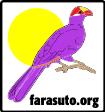 The enamel badges
The enamel badges
The enamel badges were taken out to The Gambia in early November by some birding visitors, to whom our sincere thanks for the favour. The badges were made in early 2010 and their planned delivery in April was prevented by the volcano. They are being sold, organised by the KBO, with all proceeds going to support work at Farasuto. Our since thanks again to the sponsor of their manufacture.
A camera for Abdul Karimu
Abdul is one of the gate-men for Farasuto and he is very enthusiastic about the site’s butterflies – he reported several sightings of what be believed to be female Senegal Palm Forester, Bebearia senegalensis, at Farasuto. The species is otherwise known only from Abuko and has not been confirmed there for some years now; see the Management Plan, page 44. In order that Abdul should at least have the chance of confirming his sightings he has been give a butterfly net and a Mr Peacock kindly sponsored a digital camera which is now with Abdul. We eagerly await butterfly photographs from Abdul – he should be able to add to the current butterfly list of 56 species.
10.4 A new bird species for the forest
David Hallam visited The Gambia in December and spent a short while at Farasuto with a guide. During the visit in which he saw disappointingly few birds he did find (and photograph) a White-shouldered Black Tit, Parus leucomelas, in the forest (normally a bird of dry savannah woodlands; Barlow et al. 1997). It is the 97th bird species to be recorded from the forest and number 302 for the area around the site. David also gave an account of what he believed to be two otters Lutra species, by the path to the mangroves - they are certainly new to the site.
John Tucker
6 January 2011

